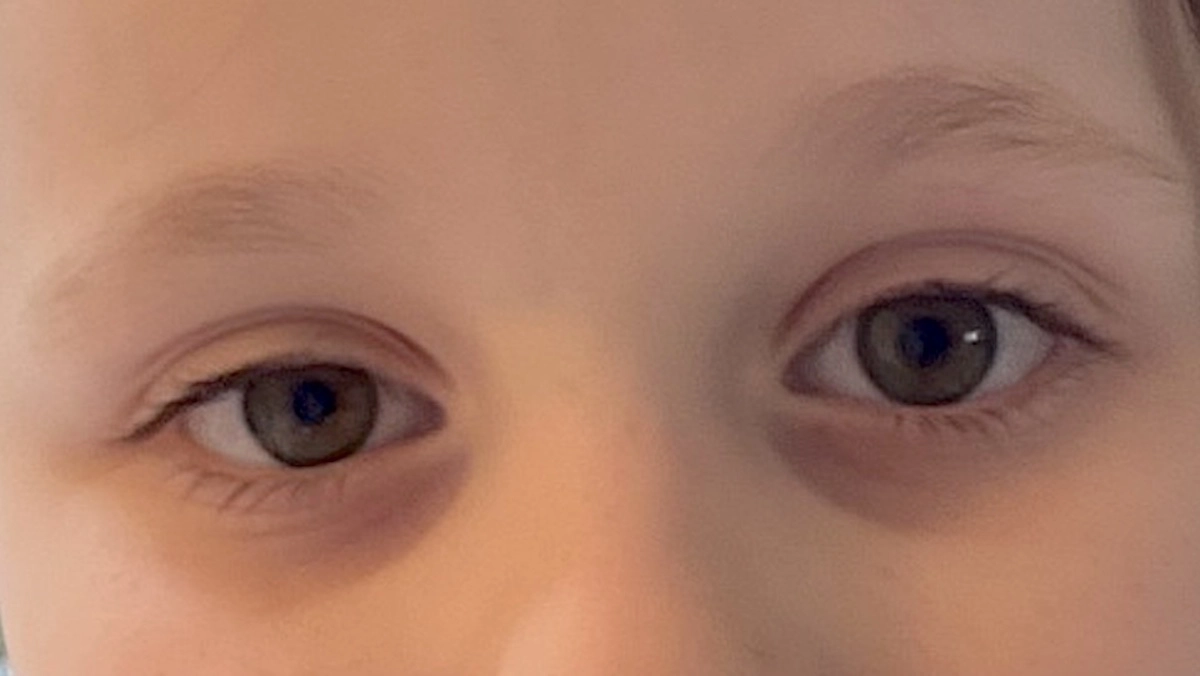
Dark circles under the eyes in kids are common. It can stem from genetics or other causes, such as allergies or a lack of sleep. The circles may be brown, purple, or blue, depending on skin tone.
Several factors can contribute to dark circles under the eyes. These include genetics, thin skin, lack of sleep, dehydration, congestion, sun exposure, nutritional deficiencies.
Genetics: For some people, dark under-eye circles are simply part of their appearance. They do not occur due to a medical condition and are just how their skin has developed. Researchers believe that periorbital hyperpigmentation could be hereditary in some people.
Thinner skin or capillaries under the eyes may be another explanation for dark circles. A 2019 study found that thinner skin under the eyes had links to more visible under-eye circles. This was true across white, East Asian, and African skin types, according to the researchers.
Lack of sleep: Many people associate dark circles under the eyes with a lack of sleep. No clinical evidence has proven that lack of sleep directly causes dark circles, but it is possible that tiredness may lead to puffy eyes, which could cast a shadow below the eyes, according to the American Academy of Ophthalmology.
Children need more sleep than adults. The Centers for Disease Control and Prevention (CDC) recommends the following amounts within a 24-hour period:
- 11–14 hours for children ages 1–2 years
- 10–13 hours for kids ages 3–5 years
- 9–12 hours for kids ages 6–12 years
- 8–10 hours for people ages 13–18 years
Some other signs a child might not be getting enough sleep, in addition to dark circles, could include tiredness, irritability, difficulty concentrating.
Dehydration: Research from 2019 states that dehydration is a potential cause of dark under-eye circles. This is because, when the skin contains enough moisture, the contours of the eye socket are less visible. In contrast, moderate dehydration can cause slightly sunken eyes, which can make dark circles look darker. Other symptoms of moderate dehydration in children include irritability, faster breathing, increased heart rate, decreased urination.
If a child has signs of dehydration, giving them water or sports drinks can help. If it is a hot day, keep them in the shade for a while until they recover. If they do not improve, they may need medical attention. The following chart from the Academy of Nutrition and Dietetics provides an estimate of the water and beverage requirements for children:
| Age range | Sex | Cups per day |
| 4–8 years | females and males | 5 |
| 9–13 years | females males | 7 8 |
| 14–18 years | females males | 8 11 |
Some children may need more or less than these amounts depending on a variety of factors.
Allergies: Allergies can cause chronic dark circles, which some people refer to as allergic shiners, as they can resemble a black eye. If an allergy is the cause of the dark circles, a child will have additional symptoms, such as a blocked or runny nose, itchy or swollen eyes, sneezing and possibly hives.
Sun exposure: Exposure to UV light can cause the skin to produce more melanin, which is the pigment that gives skin its color. This may alter a child’s skin and make preexisting dark circles more visible.
Nutrient deficiency: The aforementioned research from 2019 notes that inadequate nutrition could also cause dark circles. If a child eats a limited number of foods, has a plant-based or vegan diet, or has other unexplained symptoms that could suggest a deficiency, caregivers should speak with a pediatrician.
A doctor will be able to take a dietary history or run tests to determine whether a child has a deficiency and suggest ways of increasing nutrients through diet or supplements.
Do dark circles always need treatment? No, dark circles do not always need treatment. For many people, it is part of their appearance, rather than a symptom of a medical condition.
When they are older, children who naturally have dark circles may want to alter their appearance, such as by wearing makeup. However, if dark circles appear to get worse, or come with other symptoms, this may mean a child needs medical attention. Depending on the cause, this could include:
- trying interventions to help children get more sleep
- ensuring children remember to drink enough fluids
- trying new approaches to food to encourage them to eat a varied diet
- seeking treatment for allergies
- protecting the face from sunlight with hats, shade, or child-friendly sunscreen
If dark circles manifest in only one eye or occur with swelling, or the child becomes listless and lethargic, seek medical help.
In summary, dark circles under the eyes are common, including in kids. Many factors may contribute to them. It may be a product of genetics or having thinner skin under the eyes.
In other situations, dark circles that appear for the first time, get worse, or come with other symptoms could be a sign of an underlying condition, such as dehydration, allergies, or a nutritional deficiency.
When the circles stem from a medical cause, treatment can address the underlying condition. If the dark circles appear in only one eye or worsen, or a child has other concerning symptoms, contact your doctor.
Source: https://www.medicalnewstoday.com/articles/dark-circles-under-eyes-for-kids?











